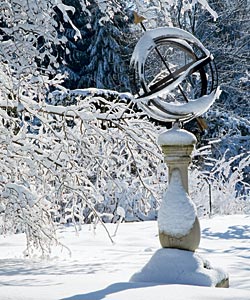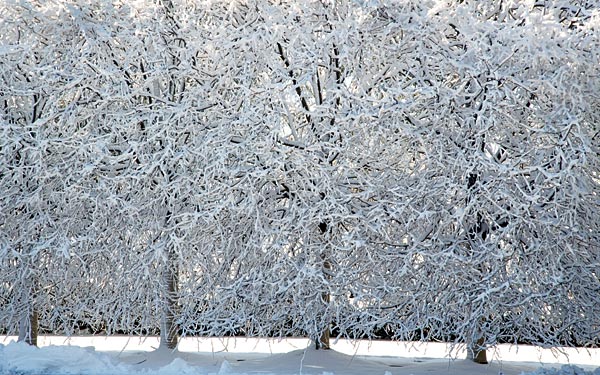Some winter days, it looks as if the artist Christo had come to town and wrapped everything in billowy white fabric. The landscape stands motionless inside its wrap of snow, angles softened, bumps and cracks and shades of gray and green minimized.
At this North Shore home, the dramatic look that a snowfall creates on its roughly two acres of grounds is the result of thoughtful planning by Deborah Nevins, a New York–based landscape designer. While the home is in the suburbs, she says, "it’s more of a city house than a country house," with homeowners who are "not going to go out into the fields and go ice skating on a pond." They’re going to be inside, working or entertaining or relaxing throughout the week, so the views of the garden matter. "You can watch the snow fall and transform the sculptures or the hedges into something different than they were the day before," Nevins says.
She chose hardscape elements such as a pergola and plantscape elements such as an allee of linden trees "as much for winter as for summer, because you need it to look good always." She chose, for instance, hawthorn trees over cherries for their bright, hanging berries.

An armillary sphere becomes more sculptural when lined with snow. Photo Gallery »
She wasn’t planning expressly for snow, she says, but for the season in general. "If you give the garden good structure, it will look good throughout winter," Nevins says. Hedges, pergolas, and fountains lend form to a space, their lines and textures encouraging the eye to move along prescribed lines.
"You could have a snowless winter and still enjoy looking out at the garden," Nevins says. "The snow is kind of an additional benefit."
To the homeowner, snow provides a metaphorical change of tune. Summer’s bountiful, colorful garden, she says, is "robust, wonderful, like a great symphony orchestra playing Beethoven’s Ninth"; when the snow blanket is spread over the garden, "it’s more like Mahler. It’s very re;flective, peaceful, and serene."
By the time the homeowner and her husband set out to build the house in the mid-1990s, they had traveled enough in Europe to know that they wanted "something that felt like a French country home—not a chateau, but a place where you could look out into your gardens and smell the earth and enjoy the birds."
That translated, for Nevins, into a landscape design that put handsome views outside every window, a walkable garden that is formal without being imposing or forbidding, and a layout peppered with "discoveries," so there would always be a reason to get out of the house and into the garden.
All of those criteria apply year-round. "These are people who use their garden," Nevins says. "It has to be there for them any day." She met that need by creating a series of seven garden rooms, and a tracery of walking paths that knit it all together. "There shouldn’t be deadends," she stipulates. The allee of pleached lindens has a monumental feel, but "to walk from one end to the other takes less than two minutes," she points out. (That may be enough on some bitterly cold days.)
The evergreens and berry-bearing woody plants that Nevins planted in sight of windows "bring us joy indoors," the homeowner says. Evergreens like the upright arborvitae and the extensive yew hedges are there as green relief from the browns and grays of bare trees. (In a setting with a more lasting and consistent snow cover, Nevins notes, she’d use more of them because "they hold snow in these beautiful sort of puffs.") Plants with berries—yews, winterberry, viburnums, and hawthorns (whose "berries" are technically known as haws)—provide pendulous bits of color and attract birds to the garden in winter, "so wonderful to watch from the windows," the homeowner says.
To further accommodate winged life in the garden, the homeowners put out an assortment of birdhouses. They keep a fountain running year-round, both for the birds and for the aural appeal of the trickling water. Abundant evergreens provide nesting cover for the birds.
Not as helpful to the birds are two neighborhood cats who "show up here every day in the winter," the homeowner says. Their little paw tracks through the snow are a source of delight and curiosity for her and her guests.
Nevins points out that the formality desired for this yard did mean excluding some plants that can enhance winter gardens—dogwood varieties with red or gold twigs, in particular. Both light up like neon signs in a wintry landscape but "wouldn’t have fit in here."
But other trees do, handsomely. The homeowner points to a century-old maple and an equally old elm that were protected during construction of the house 15 years ago. "Their bark is breathtaking in winter," she says. "They’re like architectural pieces on our lawn. And that’s what the whole winter aspect is—it’s like architecture. The rhythm is serene and calming. When the sun comes and sparkles on the snow, what you feel is joy."
Photography: Linda Oyama Bryan
Related:



